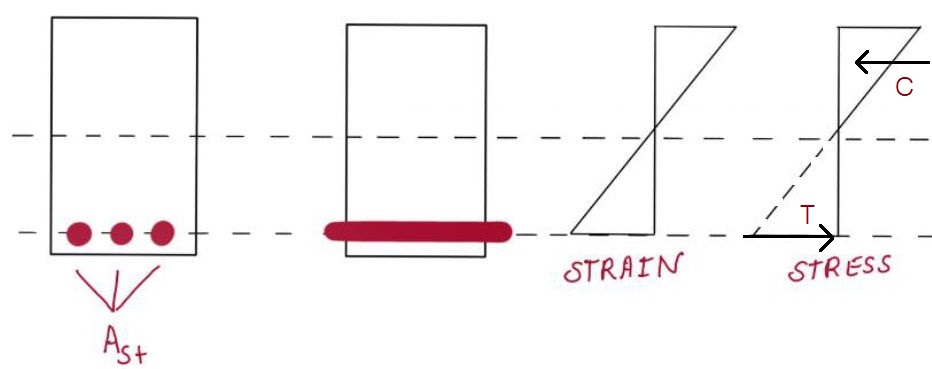You might have seen old buildings generally have beams and columns of big cross-sections. Do you wonder why that is so? Are they expected to bear high loads? Well answer to these questions lies in knowing about the working stress method design philosophy of concrete. So, let’s understand this.
Working Stress Method
This is the traditional method for reinforced concrete, structural steel, and timber design. This method is also known as the Modular method. The main assumption of the working stress method is:
- The plane section before bending remains the plane after bending.
- Materials behave in a linear elastic manner.
- There is strain compatibility between steel and concrete.
- Stresses in materials are not allowed to exceed the permissible stress under the working load. $$ Permissible \: stress= \frac{Strength \: of \: material }{ Factor \: of \: safety} $$
- The concrete below the neutral axis is considered to be cracked, and all of the tension is taken by steel only.

Deficiency in Working Stree Method:
Apart from its simplicity, there are major drawbacks to this method. They are:
- It may not be possible to keep the stress within the permissible limit considering
- The long-term effect of creep and shrinkage.
- Effect of stress concentration and other secondary effects.
- All such effects result in significant local increases in stresses into the inelastic range and redistribution of the calculated stress.
- In the working stress method of design, the actual margin of safety is not equal to the factor of safety used because the stress-strain curve is not linear up to collapse. $$ Actual \: margin \: of \: safety= \frac { Collapse \: load }{ Working \: load } $$
- FOS used in this method has no sound theoretical basis.
- In this method, the actual margin of safety can’t be determined, and FOS is not equal to the load factor ( Due to the nonlinearity of the stress-strain curve).
- This method failed to discriminate between different types of loads that act but have different degrees of uncertainty. For example, dead load and wind load produce counteracting stresses but if they are simply added, the design load would be much larger.
- Due to its simplicity, it is still used for some structures and in cases where serviceability criteria are very important for example in the case of Water Tank design.
Conclusions
Being simple to use and easy to understand, the use of this method is very limited due to its limitations. However IS456:2000 has put this method in the annexure, so it is important to learn this method.
Some key learnings from the post:
- Assumptions: All the main assumptions are listed here. They are self-explanatory.
- Deficiency: Major drawback of the working stress method is it does not use the reserve strength of concrete which makes the larger cross-section and results in an uneconomical section design